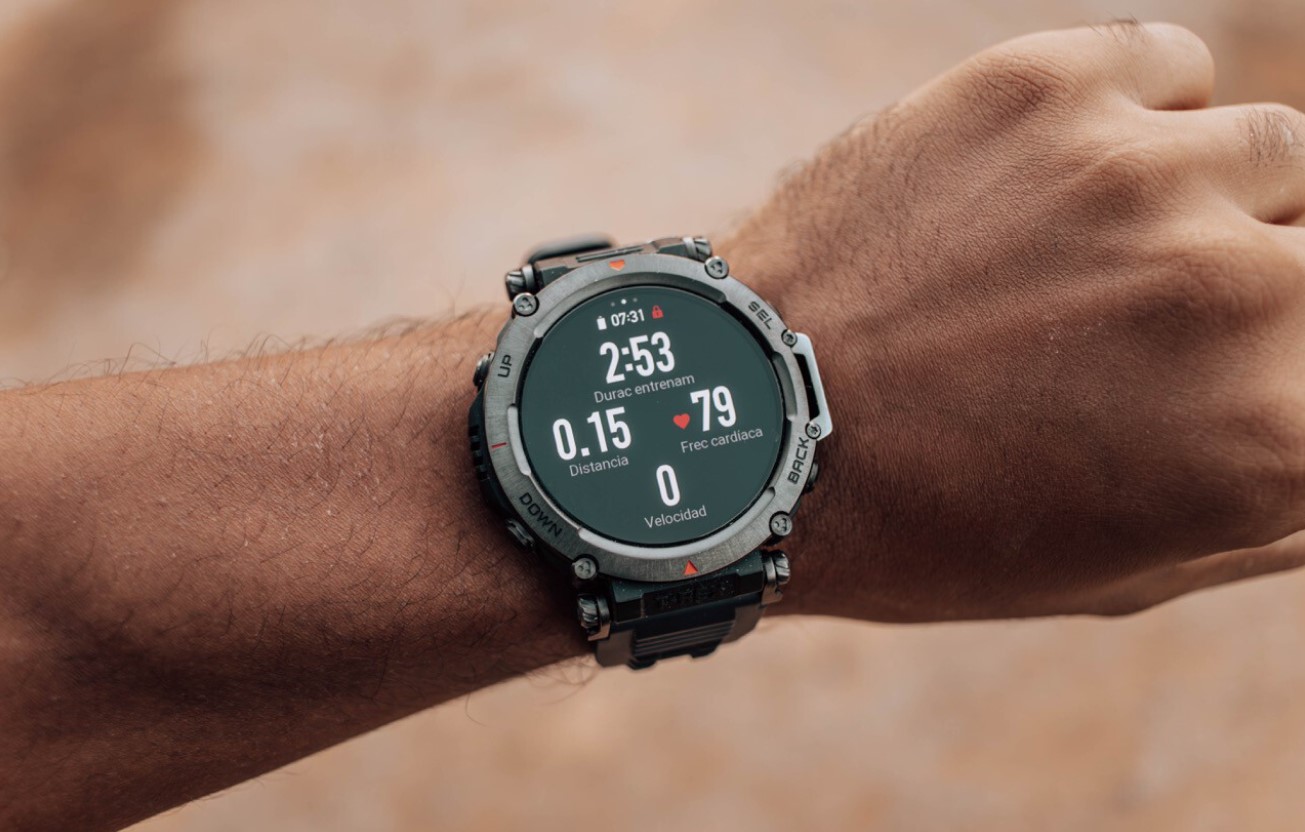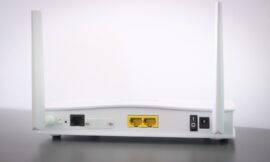The previous Amazfit T-Rex, was an endurance-oriented sports watch. The Amazfit T-Rex Ultra is the evolution of this model, and it represents a qualitative leap in practically all areas that could be improved.
I have been able to test this watch for about a month, and I am clear about its strengths and weaknesses. In this review, I will share my insights with you. So sit back and relax, because this is an Amazfit with a lot to offer.
| DIMENSIONS AND WEIGHT | 47.3 x 47.3 x 13.45mm89g |
|---|---|
| MATERIAL | Stainless steel bezel, case back, bridge and buttonsPolymer alloy center frame |
| SCREEN | AMOLED1.39″454x454326GlassBrightness up to 1,000 nits |
| STRAP SIZE | 22mm |
| CONNECTIVITY | GPS2.4GHz Wi-FiBluetooth 5.0 BLE |
| SENSORS | BioTracker™ PPG biometric sensor (supports blood oxygen measurement)Acceleration sensor Gyro sensor Geomagnetic sensor Barometric altimeter Ambient light sensor |
| ENDURANCE | 10 ATMMIL-STD-810G |
| BATTERY | 500mAh |
| COMPATIBILITY | Android 7.0 and above,iOS 12.0 and above |
| SOFTWARE | Zepp 2.0, Zepp app |
| PRICE | $469.90 |
A design and screen that level up
Regarding the design, this Amazfit T-Rex Ultra abandons the polymer construction to have a stainless steel casing, bezel and buttons. The change in materials has been noted for the better, although the central frame (the part that occupies the most volume of the watch) is still made of plastic. This makes quite a bit of sense, as an all-aluminum build on such a thick device would have increased the weight noticeably.
When building the device, Amazfit has done it thinking that the watch will get wet, dirty with mud and so on. Therefore, they promise that it is perfectly sealed and that the buttons are resistant to mud and sediment. In these weeks of use it has taken a few hits with bars, it has suffered a lot of sweat, and everything remains perfectly. It is striking how well the strap collects sweat, drying in a matter of minutes.Military-grade strength and top-tier materials: It’s not just a tough watch, it’s a premium watch.
Of course, like the previous model, it is MIL-STD-810G military-grade certified, as well as resistant to temperatures between 70 and -40°C. The only lag is that it is not a completely comfortable watch for day to day, especially due to its thickness of 13.45mm.
The watch has a total of four buttons: ‘Up’, ‘Down’, ‘Select’ and ‘Back’. As we pointed out in the last generation, there may be too many. Later, in the interface section, you will understand why it is not a good idea. A circular crown would have suited him better.
Regarding the panel, it has taken an important leap. It still has 1.39 inches, AMOLED technology and 454 x 454 resolution, but it has a maximum brightness of 1,000 nits. Although it is not a sapphire panel, I have to say that it supports micro-abrasions and small scratches very well. It does not have the slightest scratch after having used it in intensive training. The watch has automatic brightness, which works perfectly.
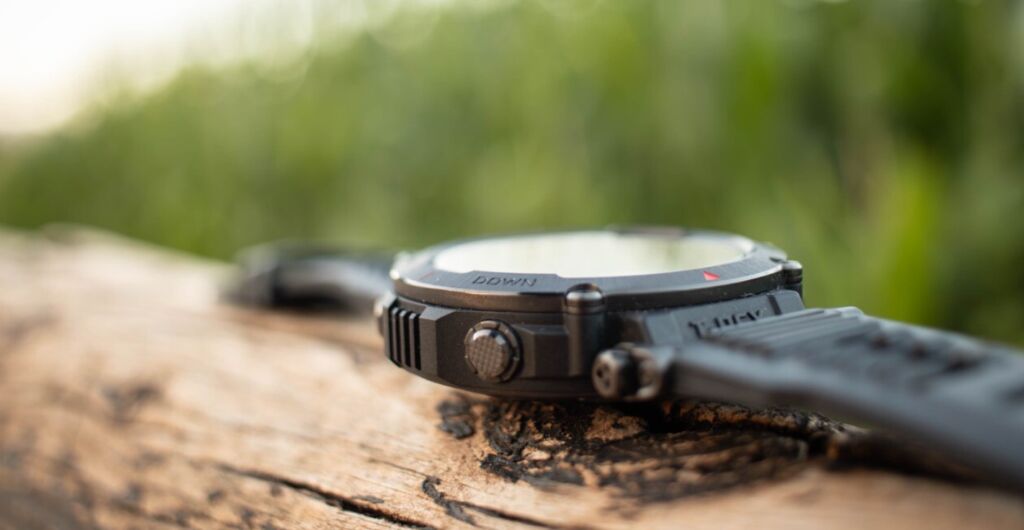
The oleophobic treatment on the watch could be improved, as it easily becomes covered in fingerprints after a few minutes of touching it. The watch has more than 120 spheres, Always on Display mode, and is the expected panel for a watch of this type. It responds very well to tactile pulsations and is a logical evolution compared to the previous one.
Performance and software: on the right track, although with room for improvement
Whenever I analyze an Amazfit I end up with mixed feelings in software. With the T-Rex and its four buttons, even more. But let’s start talking about the good, because there is enough. The operating system of this watch is Amazfit OS, a software that moves very smoothly and quickly. It has the main sphere and a control center by sliding from top to bottom in which we can control brightness, silent mode, autonomy, connections, etc.
When we swipe from the main sphere to the left, we access the notifications menu. In this menu, we find two small problems: we cannot respond to notifications, emojis are not displayed, and there is no integrated browser to click on web links. Despite this, the way to interact with the touch panel is remarkable.
Sliding from bottom to top, we have a summary panel with the current date, weather conditions, summary of the last training, current training load, heart rate and blood oxygen saturation. Complete, very complete.
Finally, if we slide from the main sphere to the right, we have the list of applications and modes. As you can see, everything can be accessed without touching a single button. So why so much button?
For example, the ‘back’ button, if we press it from the main screen, does exactly the same as the gesture on the right: it opens the list of apps. The ‘Select’ button opens the list of modes. The ‘Up’ button does exactly the same thing as the top swipe gesture (open the control center), and the ‘down’ button does the same thing as the down swipe gesture. As you can see, there is some logic, since the buttons do the same thing as the gesture that is in that position.
There is logic in the operation of the buttons, but a crown type operation or a reduction in the number of them would be welcome
However, since this is a panel that works with wet fingers, not as much button is necessary. In fact, there are buttons that I have only touched once to see exactly what they do, never to press them again.
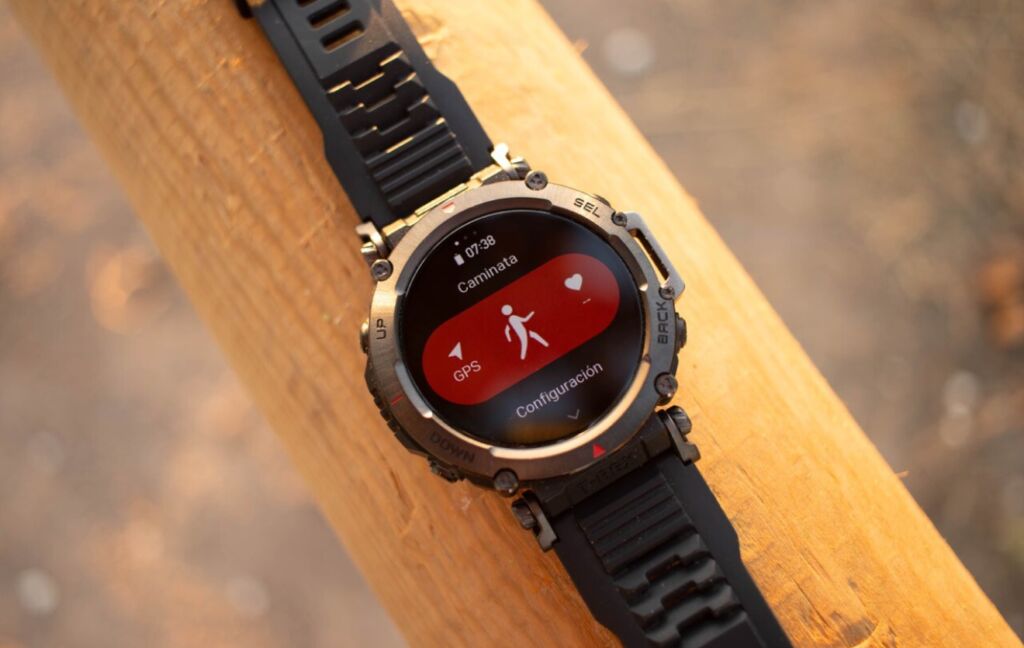
We have also once again found the system somewhat chaotic for the simplest thing a sports watch should do: activate the sports modes:
- We select the sport mode.
- We click on it.
- The GPS is looking for a signal.
- We have to click on the interface, which changes between green and red depending on whether or not the GPS is found, since otherwise training monitoring is not activated.
- As soon as we inadvertently press a physical button to go back, the monitoring is cancelled.
The simplest thing would be that, if we want to run, we hit the running mode. But it doesn’t work like that. We have to hit the mode, wait for it to pick up a GPS signal, press again and start training. We can’t go back or check notifications or do anything else: if we’re training, the interface gets stuck in this mode.
Saving this problem and leaving aside the interface of the watch itself, it is worth noting that the phone app is more than complete. The measurements on sleep, heart rate and blood saturation, the watch’s own app store, its settings… There is practically no parameter that we cannot configure.
I mainly highlight the breakdown of sleep (time asleep, regularity, sleep phases, naps, quality of breathing, etc.). Among the alternatives that do not bet on WearOS, it is by far the most complete.
Doing sports with the Amazfit T-Rex 2
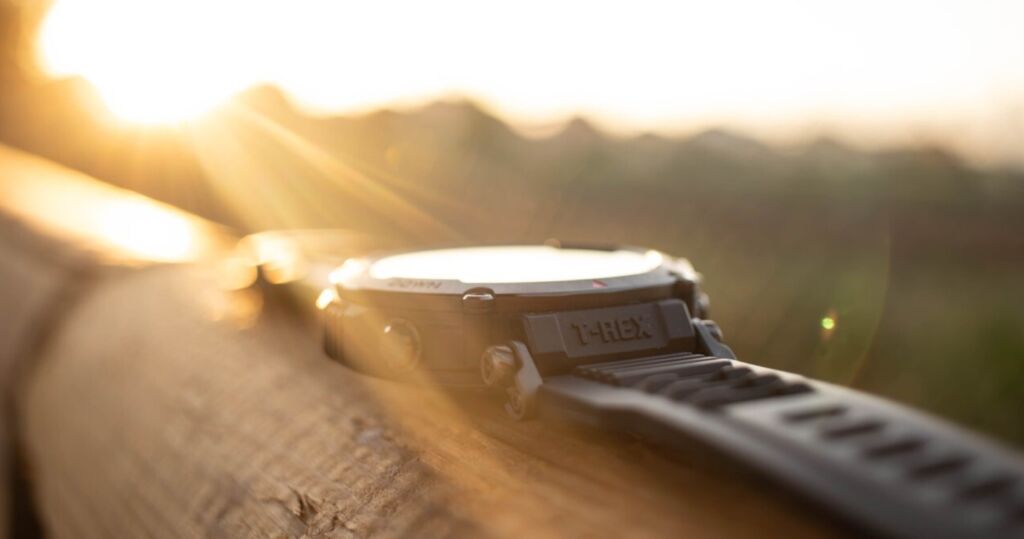
The Amazfit T-Rex 2 is a smartwatch born for and to play sports with. This generation has given a twist to the number of exercises that we can monitor. There are so many that we even find general categories to group the different sports, for example:
- Cycling : cycling, spinning, BMX and mountain biking.
- Outdoor sports : mountaineering, hiking, orienteering, climbing, fishing, hunting, skateboarding, quad biking, off-roading.
- Boxing : Boxing, Wrestling, Martial Arts, Tai Chi, Muay Thai, Judo, Taekwondo, Karate, Kendo, etc.
- Ball sports : Soccer, beach soccer, basketball, volleyball, beach volleyball, rugby, hockey, table tennis, polo, etc.
- Running sports : outdoor running, walking, treadmill, athletic walking, track running, etc.
Let’s do sports outdoors, indoors, in the pool, sea or mountains (or even in a vehicle), there will always be an option available. In a first contact, it is somewhat overwhelming to have so many options, but if we practice a specific sport on a recurring basis, we can always add it to the main list to have it more at hand.
Regarding the measurements, I have to say that I am satisfied with the results. In my case, I practice strength sports, and the metrics in the Zepp app are more and more complete. First of all, we are shown a summary table with the training time, average heart rate, calories burned and, ultimately, all the data related to the training session.
After this table we have the graphic breakdown of our heart rate, to appreciate how it has fluctuated throughout the session. It is especially remarkable how it discerns between anaerobic, aerobic, intensive or VO2 Max zones. These graphs help us to understand even better what percentage of the training has been done at certain intensities.They have yet to refine its operation with updates, but this T-Rex Ultra is capable of measuring which muscles have been involved in the training
One of the great novelties of this Amazfit T-Rex Ultra is that it claims to be able to distinguish the muscles that we have used during training. In my case, I practice crossfit, so I had it quite easy: practically all the muscles are involved. During the first sessions, however, he was not able to register the muscle groups used.
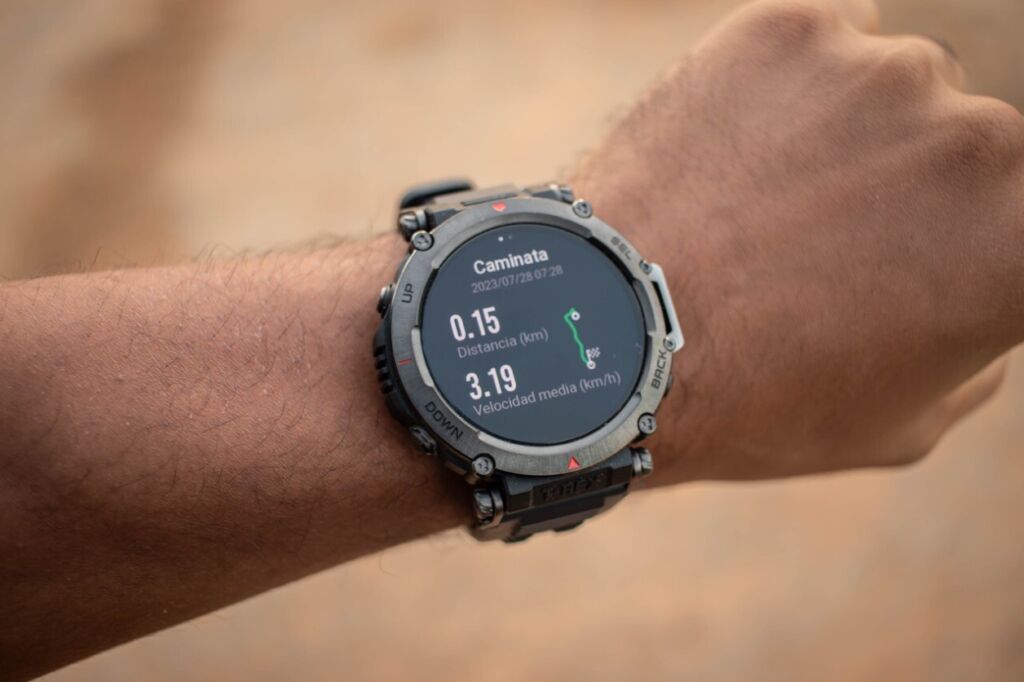
To make it easier for you, I logged an hour session on a chest – biceps and triceps workout. After this workout, he was able to indicate triceps involvement, but registered neither chest nor biceps, despite having done even more sets of these two muscles. It is more than likely that with future updates, this measurement of used muscles will improve.
If we are runners, we practice bicycles or any other outdoor sport, we will have the support of dual-band GPS. This allows you to record the route from the watch itself, so it is not necessary to carry the phone with you to see the graphs. All the data you record during the run will be automatically dumped when you get home when you connect to the phone.
Autonomy: nothing to worry about
If you want autonomy, buy yourself an Amazfit. It’s something I often repeat to my acquaintances when they ask me for recommendations, and this new T-Rex Ultra is no exception. I have managed to reach almost two weeks of use with this watch, recording two daily training sessions throughout the week, although with hardly any use of GPS (if we train for running, hiking, etc. and want to use this function, the battery will last significantly less). Auto brightness work, being so conservative, helps to save energy.
Regarding the load, it takes about an hour and a quarter to complete up to 100%. It is an outstanding figure for a watch that with a 50% battery is already capable of offering almost a week of use.
